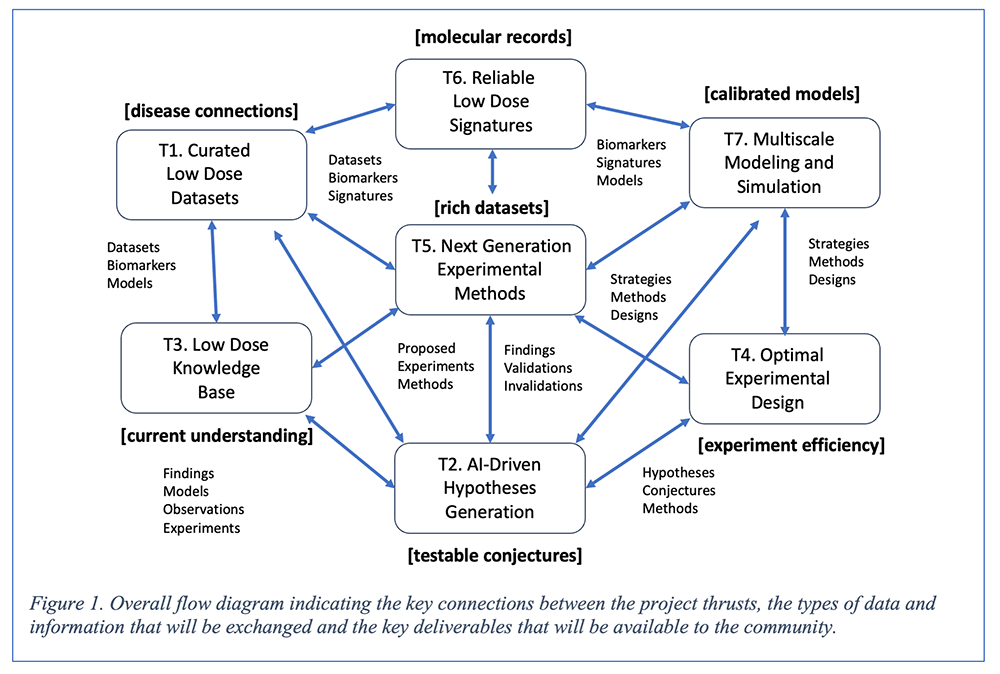Computation and Data-Driven Discovery
LUCID: Low-dose Understanding, Cellular Insights, and Molecular Discoveries
The biological impact of low-dose (LD) radiation exposure remains an open question in radiation biology research with significant implications for human health risk assessment, policy, and regulations. This project is building on advances in artificial intelligence (AI); high-throughput experimental technologies; and multiscale modeling and simulation to advance scientific understanding of the molecular and cellular processes involved in LD radiation exposure and cancer risk, accelerate discovery, and connect insights across scales.
LUCID, a multi-institutional effort, involves seven interdependent project thrusts that aim to accelerate discovery in LD radiation research. A collaborative framework that couples hypothesis generation, experimentation, modeling, and data can overcome historical challenges in this field, leading to new insights into the health effects of LD radiation exposure.

Thrust Areas
T1. Creating curated multimodal population health datasets that can be used to connect LD exposure to potential downstream biologic effects and their associated health outcomes. LUCID will identify, acquire, and integrate datasets to study the independent and synergistic biological effects of LD exposure.
T2. Building and deploying an AI-based Hypothesis Generation Engine (HGE) to systematically generate, evaluate, and score hypotheses related to LD radiation effects, biological processes, and linkages to cancer across the combined corpus of literature that can be tested experimentally or via modeling and simulation.
T3. Constructing a definitive LD radiation effects knowledge base (LD CATALOG) that captures key findings in compact, computable forms from the literature, experimental datasets, molecular process models, and multiscale simulations. This knowledge base will enable researchers and AI systems to explore connections across experiments, populations, simulations, and theories.
T4. Developing optimal experimental design methods to efficiently test LD-related hypotheses in automated high-throughput experiments and simulation campaigns. These techniques will be integrated into an online service that researchers can use to optimize experimental resources.
T5. Pioneering new experimental approaches by combining high-throughput screening, three-dimensional cell cultures, and optimal experimental design. LUCID aims to develop and apply these techniques to crucial open questions in LD radiation research.
T6. Advancing understanding of mutational signatures of LD exposure and potential LD-induced tumors to improve the reliability of existing signatures and search for additional signatures related to LD exposure.
T7. Developing a multiscale modeling and simulation framework to estimate cancer risk from LD radiation exposure. LUCID will develop molecular, cellular, and tissue scale models; connect them with mutational signatures and population data; and validate them using targeted experiments. This framework can explore the effects of LD radiation under different exposure scenarios to quantify uncertainties in risk estimates.
The Brookhaven Lab team is contributing to various LUCID components, namely T3, T4, T6, and T7, each with specific objectives. T3 aims to employ datasets and corpora for the purpose of distilling a knowledge base consisting of well-established mechanistic insights within the LD biology field. In turn, these foundational mechanistic understandings serve as valuable inputs to enhance the productivity of T1 and T2, subsequently influencing and informing the activities of T6 and T7. T4 is tasked with the enhancement of experimental designs undertaken in T5 and plays a pivotal role in shaping and optimizing the recommended strategies for experimental validation in alignment with the hypotheses generated in T2. T6 leverages the datasets from T1, the conjectural content of T2, and the knowledge base of established findings from T3 to refine and enhance prior information, improving the approach to refining LD signatures. T7 integrates results from T1, T2, T3, T5, and T6 to improve multiscale models. This comprehensive framework represents a contemporary and robust scientific capability that leverages AI-centric methods to seamlessly consolidate data, theoretical constructs, experimental endeavors, and simulation-based approach for the advancement of discovery within the realm of LD biology./p>
Through seamless connectivity facilitated by Application Programming Interfaces and advanced workflows, this initiative endeavors to establish a resource accessible to the wider external academic community during its second phase.




